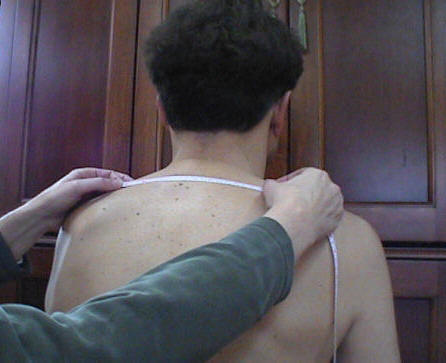|
Introduction
Height/Weight
Knee Height
Frame Size
Weight for Height
Circumference
Circumference Tables
Body Fat
Body Fat Tables
Abdominal Fatfolds
Anthro Tables
Summary
Resources
|
Additional anthropometric
measurements can be taken to monitor changes that may occur in chronic disease
states that are associated with hormonal alterations. Following are techniques
for some suggested measures to capture information on trends. Therapies targeted
to improving body habitus can be quantified.
Back measure:
|
Ask the client to stand (or sit) tall and in their
best posture. Hold tape measure from outside edge of acromion processes
across the back. Measure to the nearest millimeter. |
 |
Dorsocervical fat ridge
and/or knob:
|
Ridge Width:
From the right and left acromion processes, palpate toward the center of
the back below the neck to determine the existence of a ridge (sometimes
firm and sometimes spongy). Make sure to differentiate from muscle ridges.
Measure width of ridge on the outside edges to the nearest millimeter.
|
 |
|
Ridge Height:
From the center of the back about mid-scapula, and from the
bottom of the skull, palpate to detect ridge and measure height to the
nearest millimeter.
Knob Width and Height:
Carefully palpate the dorsocervical area to identify
potential lipoma "knobs" and measure width and height from outside edges
to the nearest millimeter. |
Abdominal Area Measures:
Abdominal circumference:
Ask the client to stand relaxed. Wrap tape measure around torso at the
umbilical level (usually about 2.5-3 cm below the waist) and parallel to
the floor. Measure abdominal circumference at the umbilical level to the
nearest 1/10 cm. |
|
Additional abdominal measures:
(taken to provide a range of
circumferences)
As you continue to hold the tape around the middle with both hands, ask
the client to "suck in" their belly as much as possible and record measure
to nearest millimeter. As you continue to hold the tape in place, ask the
client to push out their belly ("like you are very pregnant") and measure
to the nearest millimeter. |
|
